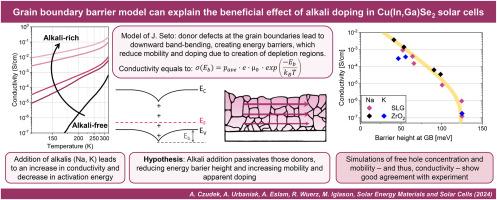晶界势垒模型可解释 Cu(In,Ga)Se2 太阳能电池中碱掺杂的有利影响
IF 6.3
2区 材料科学
Q2 ENERGY & FUELS
引用次数: 0
摘要
尽管数十年来人们一直知道 Cu(In,Ga)Se2 碱掺杂的有利影响,但对其确切的物理途径仍未达成一致。在这项工作中,我们提出了一个案例,说明这种效应与碱诱导的晶界(GB)势垒钝化有关。在这个模型中,C-S.Jiang 和 U. Rau 等人早先提出的这一模型中,晶界处的供体缺陷会导致向下的带弯曲,为空穴产生能量障碍,从而降低晶界间的迁移率,同时导致晶界周围产生贫化区,降低表观掺杂浓度。我们对掺入不同浓度碱金属(Na 和 K)的 Cu(In,Ga)Se2 薄膜和太阳能电池进行的系统研究结果表明,无论使用哪种碱,碱效应都会导致自由空穴浓度和空穴迁移率同时增加。此外,随着碱浓度的增加,与 GB 势垒高度相关的导电活化能也在降低。上述所有结果都与晶界钝化模型一致。为了进一步验证这一假设,我们将实验结果与 SCAPS 模拟多晶粒 CIGS 薄膜的结果进行了比较。这些模拟结果与实验结果在电导率、自由空穴浓度和 GB 势垒高度方面的定量结果非常吻合。本文章由计算机程序翻译,如有差异,请以英文原文为准。

Grain boundary barrier model can explain the beneficial effect of alkali doping in Cu(In,Ga)Se2 solar cells
Although the beneficial effect of alkali doping of Cu(In,Ga)Se2 has been known for decades, there is still no agreement on its precise physical pathway. In this work we present a case for this effect being linked to the alkali-induced passivation of barriers at the grain boundaries (GBs). In this model, postulated earlier by, among all, C-S. Jiang and U. Rau, donor defects at the GBs result in downward band bending, creating energy barriers for holes and thus reducing the intergrain mobility, at the same time leading to the creation of depleted regions around GBs, decreasing apparent doping concentration. The effect of alkali doping would be through passivation of those donor defects, increasing both mobility and doping concentration.
Results of our systematic study on Cu(In,Ga)Se2 thin films and solar cells doped with different concentrations of alkali metals (Na and K) point to the alkali effect leading to a simultaneous increase of both free hole concentration and hole mobility, irrespective of the type of alkali used. Additionally, the activation energy of conductivity – linked to the GB barrier height – decreased with an increase in alkali concentration. All of the above results are consistent with the grain boundary passivation model. To further test this hypothesis, experimental results were compared with SCAPS simulations of a multigrain CIGS thin film with varied concentration of donor defects located at the GBs. These simulations were in good quantitative agreement with experimental results with regards to conductivity, free hole concentration and GB barrier height.
求助全文
通过发布文献求助,成功后即可免费获取论文全文。
去求助
来源期刊

Solar Energy Materials and Solar Cells
工程技术-材料科学:综合
CiteScore
12.60
自引率
11.60%
发文量
513
审稿时长
47 days
期刊介绍:
Solar Energy Materials & Solar Cells is intended as a vehicle for the dissemination of research results on materials science and technology related to photovoltaic, photothermal and photoelectrochemical solar energy conversion. Materials science is taken in the broadest possible sense and encompasses physics, chemistry, optics, materials fabrication and analysis for all types of materials.
 求助内容:
求助内容: 应助结果提醒方式:
应助结果提醒方式:


